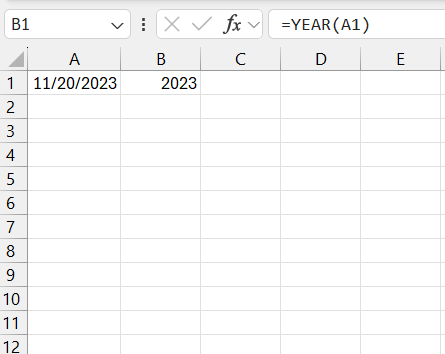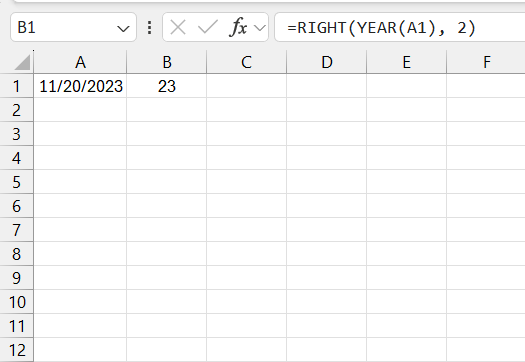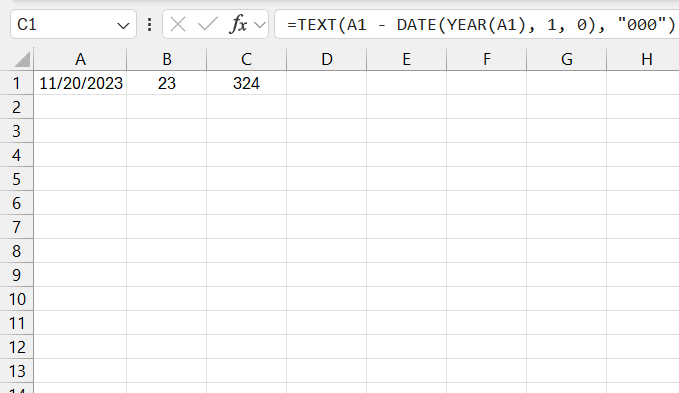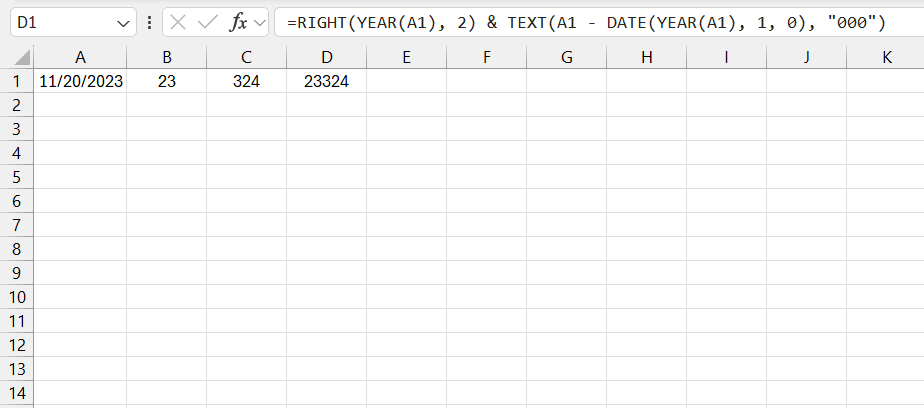Julian dates typically refer to the number of days that have elapsed since the beginning of the Julian Period on January 1, 4713 BCE. However, in more common usage, “Julian date” often refers to a format representing the day of the year (1 to 365 or 1 to 366) within a specific year. This guide will focus on converting dates to this latter format.
Key Takeaways:
- Julian Date Definition: Julian dates usually refer to the number of days since January 1, 4713 BCE but often represent the day of the year within a specific year in formats like YYYYDDD or YYDDD.
- Excel Usage: In Excel, Julian dates are used for precise and straightforward date tracking, simplifying calculations by eliminating month and day formats.
- Format Structure: The common Julian date format in Excel consists of the last two digits of the year followed by the day of the year, such as “24001” for January 1, 2024.
- Conversion Method: Converting to Julian dates involves extracting the year and calculating the day of the year, then combining them into the Julian date format using Excel functions.
- Practical Applications: Julian dates are essential in industries like finance, manufacturing, and logistics for inventory management, batch tracking, and interfacing with systems using Julian dates.
Table of Contents
Introduction to Julian Dates in Excel
What is a Julian Date?
In Excel, Julian dates play an instrumental role for those who require a continuous count of days for precision and simplicity. A Julian date, within the context of Microsoft Excel and used by various industries, is a unique serial number representing a specific date.
This number specifically stands for the elapsed days since a fixed point in time, known as the Julian day number which dates back to January 1, 4713 BC.
However, more commonly in Excel, a Julian date is referred to as the day of the year, alluding to a format like yyyddd, where ddd indicates the sequential day number from January 1st.
Understanding the Julian Date Format
The Julian date format consists of:
- The last two digits of the year
- The day of the year (ranging from 001 to 365 or 366)
For example, January 1, 2024, would be represented as “24001.”
Why Excel Professionals Need Julian Dates
As an Excel professional, dealing with Julian dates is essential because they allow us for the seamless tracking and calculation of time periods, which is especially valuable in environments like finance, manufacturing, and logistics. Julian dates simplify complex date computations eliminating month and day formats, thereby decreasing the potential for errors and enhancing our data consistency.
They are also used for inventory management and in scenarios where batch codes need to be deciphered or when dealing with data from systems that output dates in Julian format. Understanding and utilizing the conversion from Julian to calendar dates in Excel ensures data interoperability and accurate chronological analysis.
Step-by-Step Guide to Converting Dates to Julian Format
Let’s convert a date in Excel to the Julian date format. Suppose I have the date in cell A1.
STEP 1: Extract the Year.
Use the YEAR function to extract the year from the date =YEAR(A1)
This formula will give us the year of the date in A1.
STEP 2: Extract the Last Two Digits of the Year. We can use the RIGHT function to get the last two digits of the year.
STEP 3: Calculate the Day of the Year
Use the TEXT function to format the day of the year as a three-digit number.
=TEXT(A1 – DATE(YEAR(A1), 1, 0), “000”)
This formula calculates the day of the year by subtracting the date of the previous year’s December 31 from the date in A1 and formats it as a three-digit number.
STEP 4: Combine the Year and Day of the Year
Combine the two parts to get the Julian date.
=RIGHT(YEAR(A1), 2) & TEXT(A1 – DATE(YEAR(A1), 1, 0), “000”)
This formula concatenates the last two digits of the year with the day of the year to form the Julian date.
Example
If A1 contains November 20, 2023, here’s how the formula works step-by-step:
=YEAR(A1)returns2023.=RIGHT(YEAR(A1), 2)returns23.=TEXT(A1 - DATE(YEAR(A1), 1, 0), "000")returns324(November 20 is the 324th day of the year).
Combining these parts, =RIGHT(YEAR(A1), 2) & TEXT(A1 - DATE(YEAR(A1), 1, 0), "000") returns 23324.
Now we can convert any date to the Julian format in Excel using this method!
Practical Examples and Formulas
Common Julian Date Conversion Scenarios
When it comes to Julian date conversions, we often encounter a range of common scenarios that require precise handling. One scenario is when I need to interpret expiry dates on products or medications; these are frequently represented in Julian date format. Another scenario involves interfacing with systems that provide date information in Julian format—here, conversion aids in synchronizing data within Excel.
Additionally, certain scientific and research datasets use Julian dates as standard practice, necessitating conversion for analysis and reporting. In each case, it is imperative to correctly interpret and convert these dates to maintain data integrity and ensure accurate outcomes.
Advanced Techniques for Specific Julian Date Types
Mastering advanced techniques for specific Julian date types is crucial when working in domains that require heightened levels of time precision. If I’m dealing with Julian dates that include a time component (e.g. 2451545.5) in Excel, I apply a formula that separates date and time. This ensures noontime, traditionally represented by .5 in Julian date format, is accurately reflected in the converted timestamp.
For Julian dates outside the standard range supported by Excel, like in historical research or astronomical applications, I might turn to a custom VBA function or seek an external specialized tool to handle dates prior to the year 1900. These advanced methods underscore the need for meticulous conversion approaches when standard Excel functions reach their limits.
FAQs on Julian Date Conversion in Excel
How to calculate Julian date in Excel?
To calculate a Julian date in Excel, I use the formula =DATE(YEAR(A1), MONTH(A1), DAY(A1)) - DATE(1900, 1, 1) + 2, where A1 contains the calendar date I’m converting. This formula takes into account Excel’s date system, which starts on January 1, 1900. Remember to format the result as a number to see the Julian date. If a more traditional Julian date format is needed, I could use the TEXT function: =TEXT(A1,"yy") & TEXT(A1-"01/01/" & TEXT(A1,"yy"),"000"). This will create a Julian date formatted as yyddd.
How Do I Convert a Gregorian Date to Julian Date in Excel?
To convert a Gregorian date to a Julian date in Excel, I start by breaking down the Gregorian date into the year, month, and day using the YEAR, MONTH, and DAY functions. Then, I calculate the day of the year by adjusting the serial number of the date to account for the start of the year, like this: =DATE(YEAR(A1),MONTH(A1),DAY(A1))-DATE(YEAR(A1),1,0), assuming A1 holds the Gregorian date. Finally, I combine this with the year to get the Julian date in ‘yyyddd’ format using the formula =YEAR(A1)&TEXT(A2,"000"). Adjust A1 and A2 references based on your worksheet layout.
Can I Automatically Enter Today’s Date in Julian Format?
Yes, I can automatically enter today’s date in Julian format in Excel. To do this, I use the formula =TEXT(TODAY(),"yy")&TEXT(TODAY()-DATE(YEAR(TODAY()),1,0),"000"). This formula combines the current year in two digits and the day of the year in three digits, automatically updating each day to reflect the current Julian date. Just remember to format the cell as ‘General’ to display the result as text.
Is There an Excel Function That Specifically Handles Julian Dates?
No, Excel does not have a built-in function specifically designed to handle Julian dates. However, I can utilize a combination of standard Excel functions like DATE, YEAR, and TEXT to convert between Julian and Gregorian dates. Custom formulas and macros can also be crafted to handle Julian dates more efficiently, especially in large datasets or specialized applications.
How to Convert Julian Date Back to Regular Date?
To convert a Julian date back to a regular date, I can use a formula that strips the year from the Julian date and calculates the corresponding calendar date. For a Julian date in the format ‘yyyyddd’, I’d use =DATE(LEFT(A2,4),1,RIGHT(A2,3)), where A2 holds the Julian date. In this formula, the LEFT function extracts the first four digits as the year, and the RIGHT function grabs the last three digits as the day count, starting from January 1. The DATE function then combines these to give the regular calendar date.
John Michaloudis is a former accountant and finance analyst at General Electric, a Microsoft MVP since 2020, an Amazon #1 bestselling author of 4 Microsoft Excel books and teacher of Microsoft Excel & Office over at his flagship MyExcelOnline Academy Online Course.











